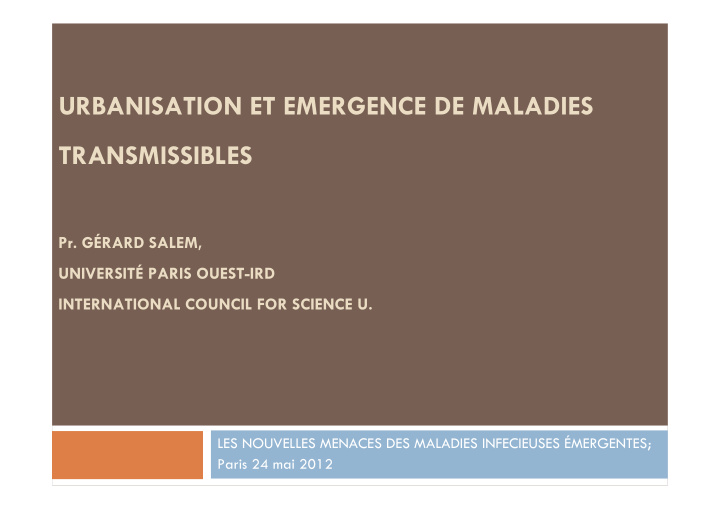



URBANISATION ET EMERGENCE DE MALADIES TRANSMISSIBLES Pr. GÉRARD SALEM, UNIVERSITÉ PARIS OUEST-IRD INTERNATIONAL COUNCIL FOR SCIENCE U. LES NOUVELLES MENACES DES MALADIES INFECIEUSES ÉMERGENTES; Paris 24 mai 2012
OUR PLANET � The world's population is growing � from 6 billion in 2005 to a projected 9 billion in 2050 � … and urbanising � 2007 : transition year ! � global urban population : 3,303,992,253 people (approx) � exceeded rural population : 3,303,866,404 people
World Urbanization Prospects : 2007, the URBAN YEAR ! � � � �
In Europe …
1960 Urban Growth in West Africa
1960 Urban Growth in 1990 West Africa
1960 Urban Growth 1990 in West Africa 2020
An urban world An urban world An urban world An urban world
General Health Impacts of Urbanisation : Infectious Morbidity 1 ) High Human Population Densities : Fast and Intense Circulation of Pathogenic Factors Earlier primary phase infections (measles, tuberculosis,etc.) � new epidemiology, strategies of immunization, etc.
Health Impacts of Urbanisation : Emerging diseases 1) High Human Population Densities : Fast and Intense Circulation of Pathogenic Factors Earlier primary phase infections (measles, tuberculosis,etc.) New Immunity � new epidemiology, strategies of immunization, etc. 2) Spatial and Social Heterogeneity � Socio-Spatial Health inequalities
Venice, Italy
Dogon cities, Mali, West Africa
Pikine, Dakar’Subur b
Slums in Nairobi
Paris PARIS
But also, slums in Paris
And new castle in Abidjan (Cote Ivoire)
General Health Impacts of Urbanisation : Infectious Morbidity 1) High Human Population Densities : Fast and Intense Circulation of Pathogenic Factors Earlier primary phase infections (measles, tuberculosis,etc.) New Immunity � new epidemiology, strategies of immunization, etc. 2) Spatial and Social Heterogeneity � Socio-Spatial Health inequalities 3) Spaces are open and interconnected � � � � intense circulation inside the urban area, between urban areas, between urban and rural areas � multilevel approaches, specially for emerging diseases
Challenges 1 � Morbidity � Old diseases (dysentery, respiratory diseases, etc.) � « New » old diseases : malaria dengue, etc � New diseases (HBP, K, diabète, etc) � � co-morbidity, co-evolution
Challenges 2 Process of emergence/process of urbanisation
Recommend
More recommend